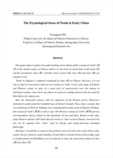

-
 * 본 문서는 배포용으로 복사 및 편집이 불가합니다.
* 본 문서는 배포용으로 복사 및 편집이 불가합니다.
미리보기
서지정보
· 발행기관 : 세계한자학회
· 수록지 정보 : 世界漢字硏究 / 1권 / 2호
· 저자명 : Youngsam HA
목차
1. Introduction
2. The Character Form of zhen (貞) and zhen (眞)
2.1. Character Forms of zhen (眞)
2.2. Character Forms of zhen (貞)
3.1. The semantic interpretation of zhen(眞) in Shuowen Jiezi(《說文解字》)I
3.2. The Usage of zhen (眞) in Ancient Literatures
3. The Compounds with zhen(眞)
4. Final Remarks on zhen (貞) and zhen (眞)
References
<中文摘要>영어초록
This paper aims to explore the understanding and evolution of the concept of ‘truth’ (眞 理) in the earliest stages of Chinese history on the basis of oracle bone script zhen (貞) and the inscriptions zhen (眞). It further aims to prove that zhen (貞) and zhen (眞) are cognate words.
‘Truth’ in English is commonly translated as zhen (眞) in Chinese. However, it is not easy to find an intersection between two notions of ‘truth’ in the early stage of Eastern and Western culture in spite of a great deal of controversies over the notions in sinological studies, since there was almost no cultural exchange between the East and the West before the modern era.
After the nineteenth century, with the expansion of the Western power, Westerners attempted to understand the manifold ways of Eastern thought. Thus, many concepts that were dominant in Western thinking were transplanted in many areas of Eastern thinking; the concept of ‘truth’ (眞理) is such a case. The Western concept of ‘truth’ (眞理) pursues correspondence theory, based on the dichotomy of true and false. Based on this idea, many Western scholars still claim that the notion of ‘zhen’ used in Chinese classical texts can not be equated with “truth” used in Europe and Anglo-American dominant philosophy.
Therefore, I would like to return to the primitive sense of truth in the oracle bone script, explore the pre-theoretic understanding of truth before concrete forms of knowledge such as Confucianism and Buddhism were introduced, to show the interconnectedness of zhen (眞) and zhen (貞).
Traditional interpretations of zhen (眞) can be roughly classified into three types: ‘a Daoist ascetic with miraculous powers’ (神仙)(see Xu Shen, Duan Yucai, et al.); ‘treasure’ (see Tang Lan, Ma Xulun, Zhou Fangfu, He Linyi, etc), and ‘death as unchanging status’ (see Shirakawa). Among these, the first version of zhen has been considered most authentic, because Shuowen Jiezi《說文解字》, the first authoritative dictionary of Chinese characters, defines zhen (眞) as “a Daoist hermit transforming shape and ascending into Heaven ( 僊人變形而登天也)” with Daoist connotations. Such interpretations, though dominent, were based on Xiaoshuan and did not seem to include closer investigations of zhen (貞), the older form of zhen (眞), based on recently unearthed literatures. Though contemporary archaeological studies provide evidence of more ancient origins, it is difficult to extract the original sense from the primitive script of zhen (貞), because it was only used as the name of a place or a person.
This paper thus follows several hypotheses: 1. zhen (眞) is cognate with zhen (貞); 2. zhen (貞) in oracle bone script means ‘to ask Heaven questions from signs or omens obtained by burning tortoise shells or animal bones’ and a person in charge of performing a divination rituals’ is known as a diviner(zhenren ‘貞人’); 3. zhen (貞) was specified into zhen (眞); 4. Under the influence of Daoism during the early Han Dynasty, zhen (眞) was defined as ‘a Daoist hermit’ (神仙), and then acquired the meaning of truth after the introduction of Buddhism.
The strategies of the paper are as follows: firstly I will analyze zhen (眞) by breaking it into its component characters and trace back its original forms and senses of zhen in oracle bone scripts; secondly, I will examine its usage in the ancient literatures based on phonetic and semantic patterns; finally I will try to place possible coordinates of ‘truth’ among constellations of various meanings of zhen (貞) and zhen (眞).참고자료
· 없음태그
-
자료후기
Ai 리뷰이 자료는 깊이 있는 설명과 다양한 예시 덕분에 과제를 작성하는 데 큰 도움이 되었습니다. 앞으로도 이런 유익한 자료가 계속 등록되기를 바랍니다! -
자주묻는질문의 답변을 확인해 주세요

꼭 알아주세요
-
본 학술논문은 (주)코리아스칼라와 각 학회간에 저작권계약이 체결된 것으로 AgentSoft가 제공 하고 있습니다.
본 저작물을 불법적으로 이용시는 법적인 제재가 가해질 수 있습니다. -
해피캠퍼스는 구매자와 판매자 모두가 만족하는 서비스가 되도록 노력하고 있으며, 아래의 4가지 자료환불 조건을 꼭 확인해주시기 바랍니다.
파일오류 중복자료 저작권 없음 설명과 실제 내용 불일치 파일의 다운로드가 제대로 되지 않거나 파일형식에 맞는 프로그램으로 정상 작동하지 않는 경우 다른 자료와 70% 이상 내용이 일치하는 경우 (중복임을 확인할 수 있는 근거 필요함) 인터넷의 다른 사이트, 연구기관, 학교, 서적 등의 자료를 도용한 경우 자료의 설명과 실제 자료의 내용이 일치하지 않는 경우
“世界漢字硏究”의 다른 논문도 확인해 보세요!
문서 초안을 생성해주는 EasyAI

